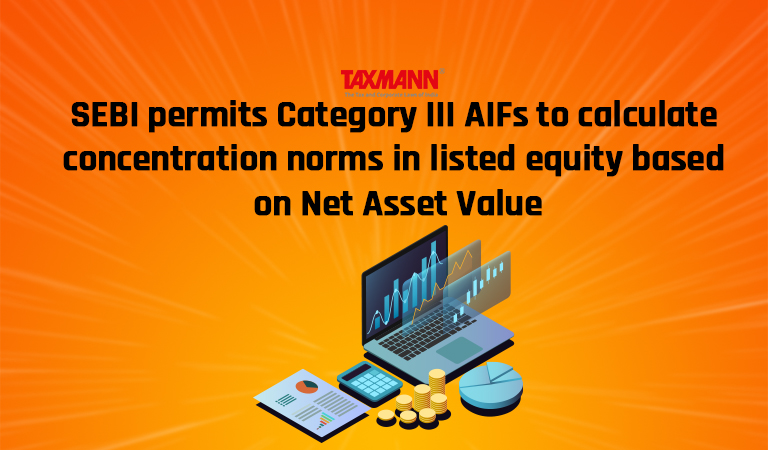SEBI permits Category III AIFs to calculate concentration norms in listed equity based on Net Asset Value
- Blog|News|Company Law|
- 2 Min Read
- By Taxmann
- |
- Last Updated on 24 November, 2021
Circular no. SEBI/HO/IMD/IMDI/DOF6/P/CIR/2021/663 Dated: 22-11-2021
The market regulator, SEBI vide notification dated 09-11-2021 had amended SEBI(Alternative Investment Funds)Regulations, 2012 permitting category III AIFs, including large value funds for accredited investors of category III AIFs, to calculate the concentration norm based on the net asset value of the fund for investment in listed equity of an investee company.
In this regard, the SEBI has clarified that the limit for investment in listed equity shall be calculated based on the NAV of the fund on the business day immediately preceding the date on which the Category III AIF makes such investment.
SEBI further clarified that the NAV of the AIF will be the sum of the value of all securities adjusted for the mark to market gains/losses. This would include cash and cash equivalents but exclude any funds borrowed by the AIF.
Passive breach of concentration norm, i.e. when the market value of the investment of Category III AIF in listed equity of an investee company exceeds the investment limits of 10% of the net asset value in listed equity prescribed of Category III AIF including accredited investors of Category III AIFs and 20% for large value funds, shall be rectified within 30 days from the date of the breach.
SEBI further specified that the requirement of appointment of a custodian shall be applicable if the sum of the corpus of the AIF and the value of the Co-investment managed by the Manager of the AIF as Co-investment Portfolio Manager is more than Rs. 500 rupees.
Click Here To Read The Full Notice
Check out NISM's (Educational Initiative of SEBI) Alternative Investment Funds (Categories I and II) Distributors | Covering all important aspects of the Alternative Investment Funds (AIFs) in India, focusing on Category I and Category II AIFs. These include the basic understanding of the alternative asset classes, alternative investment funds in India, the role and functions of various stakeholders in the AIF domain, etc.
Disclaimer: The content/information published on the website is only for general information of the user and shall not be construed as legal advice. While the Taxmann has exercised reasonable efforts to ensure the veracity of information/content published, Taxmann shall be under no liability in any manner whatsoever for incorrect information, if any.

Taxmann Publications has a dedicated in-house Research & Editorial Team. This team consists of a team of Chartered Accountants, Company Secretaries, and Lawyers. This team works under the guidance and supervision of editor-in-chief Mr Rakesh Bhargava.
The Research and Editorial Team is responsible for developing reliable and accurate content for the readers. The team follows the six-sigma approach to achieve the benchmark of zero error in its publications and research platforms. The team ensures that the following publication guidelines are thoroughly followed while developing the content:
- The statutory material is obtained only from the authorized and reliable sources
- All the latest developments in the judicial and legislative fields are covered
- Prepare the analytical write-ups on current, controversial, and important issues to help the readers to understand the concept and its implications
- Every content published by Taxmann is complete, accurate and lucid
- All evidence-based statements are supported with proper reference to Section, Circular No., Notification No. or citations
- The golden rules of grammar, style and consistency are thoroughly followed
- Font and size that’s easy to read and remain consistent across all imprint and digital publications are applied








 CA | CS | CMA
CA | CS | CMA


